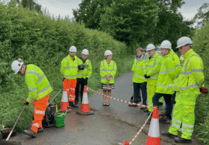SEAGRASS meadows - lush, ribbon-like fields beneath the waves, are quietly returning to the South coast of Devon and Cornwall.
These fragile underwater habitats, which play a vital role in increasing water quality, locking away carbon and providing shelter for marine life, are showing promising signs of recovery.
Now, South West Water is funding research to better understand how its operations can support the seagrass comeback and what more can be done to accelerate it.
In partnership with the University of Exeter’s Centre for Resilience in Environment, Water and Waste (CREWW), and other organisations involved in seagrass restoration such as Plymouth Marine Laboratory (PML) and the Ocean Conservation Trust (OCT), South West Water has launched an ambitious investigation into the health of seagrass beds in key estuaries across its patch, from the River Tamar to the River Exe.
Lead Researcher on the project, Dr Chris Laing, from the University of Exeter said: ‘This work represents an important step in us better understanding the impacts of waste water on coastal marine habitats.
‘Seagrass meadows are both critical habitats to protect and excellent indicators of marine health generally’.
Seagrass habitats have suffered in the past from disturbance, and poor water quality, impacted by both agricultural run-off and nutrients in treated wastewater.
In recent years the discovery of the largest known extents of seagrass beds in the UK on the southern coasts and estuaries of Devon and Cornwall have demonstrated the importance of these coasts.
This new investigation will seek to understand if South West Water’s recent significant investment in cleaner seas infrastructure and ‘Upstream Thinking’ catchment schemes that work with farmers to reduce diffuse pollution at source have made a difference in the recovery of seagrass beds
‘Seagrass is one of nature’s quiet heroes,’ said Carolyn Cadman, Director of Natural Resources and Net Zero at South West Water.
‘It helps clean our seas, stores carbon to help fight climate change and it shelters marine life.
‘We are so pleased to be working with experts at the University of Exeter and its partners to better understand how our work can help it recover and thrive’.
‘We have invested heavily in improving treatment works across the South coast,’ said Mark Worsfold, Director of Asset Management at South West Water.
‘Now, we’re seeing signs that nature is recovering.
‘This investigation will help us understand how much of that seagrass recovery is linked to our efforts and crucially, what more we can do’.
Seagrass is one of the most effective carbon sinks on Earth, capable of storing vast amounts of CO₂ in its roots and surrounding sediment.
It also stabilises the seabed, helping to protect coastal infrastructure from erosion and storm surges - an added benefit for water companies with assets near the shoreline.
But there’s more at stake than just cleaner water or stronger coastlines. These submerged meadows provide a safe haven for a wide range of sea life, from seahorses and crabs to small sharks, making them biodiversity hotspots.
South West Water’s investigation will zero in on specific locations along the Devon and Cornwall coasts, working closely with local partners already involved in seagrass planting and restoration.
As well as mapping the benefits of previous infrastructure upgrades, the research will explore future possibilities, from supporting hands-on restoration to helping the UK understand seagrass’s role in fighting climate change.
‘This is all about understanding the science and building partnerships,’ added Hannah Bailey, Biodiversity Action Officer at South West Water, who is leading on the investigation project.
‘We want to use and share our data with others - other water companies, universities, conservation charities - build a bigger picture of what works, and where’.




Comments
This article has no comments yet. Be the first to leave a comment.